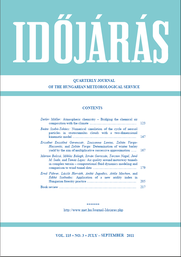Időjárás - Quarterly Journal of the Hungarian Meteorological Service (OMSZ)
Vol. 115, No. 3 * Pages 123–218 * July - September 2011
 |
|
 download [pdf: 11213 KB]
download [pdf: 11213 KB]
Atmospheric chemistry – Bridging the chemical air composition with the climate
Detlev Möller
idojaras.2011.3.1 (p. 123–)
Detlev Möller
idojaras.2011.3.1 (p. 123–)
Numerical simulation of the cycle of aerosol particles in stratocumulus clouds with a two-dimensional kinematic model
Beáta Szabó -Takács
idojaras.2011.3.2 (p. 147–)
Beáta Szabó -Takács
idojaras.2011.3.2 (p. 147–)
Determination of winter barley yield by the aim of multiplicative successive approximation
Erzsébet Enzsölné Gerencsér, Zsuzsanna Lantos, Zoltán Varga-Haszonits, and Zoltán Varga
idojaras.2011.3.3 (p. 167–)
Erzsébet Enzsölné Gerencsér, Zsuzsanna Lantos, Zoltán Varga-Haszonits, and Zoltán Varga
idojaras.2011.3.3 (p. 167–)
Air quality around motorway tunnels in complex terrain – computational fluid dynamics modeling and comparison to wind tunnel data
Márton Balczó, Miklós Balogh, István Goricsán, Torsten Nagel, Jenő M. Suda, and Tamás Lajos
idojaras.2011.3.4 (p. 179–)
Márton Balczó, Miklós Balogh, István Goricsán, Torsten Nagel, Jenő M. Suda, and Tamás Lajos
idojaras.2011.3.4 (p. 179–)
Application of a new aridity index in Hungarian forestry practice
Ernő Führer, László Horváth, Anikó Jagodics, Attila Machon, and Ildikó Szabados
idojaras.2011.3.5 (p. 205–)
Ernő Führer, László Horváth, Anikó Jagodics, Attila Machon, and Ildikó Szabados
idojaras.2011.3.5 (p. 205–)
Book review
László Bozó
idojaras.2011.3.6
László Bozó
idojaras.2011.3.6
IDŐJÁRÁS - Quarterly Journal

Az IDŐJÁRÁS a HungaroMet Nonprofit Zrt. negyedévenként megjelenő angol nyelvű folyóirata
Megrendelhető a journal.idojaras@met.hu címen.
A szerzőknek szánt útmutató itt olvasható.
Megrendelhető a journal.idojaras@met.hu címen.
A szerzőknek szánt útmutató itt olvasható.









